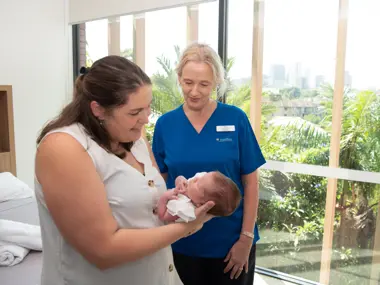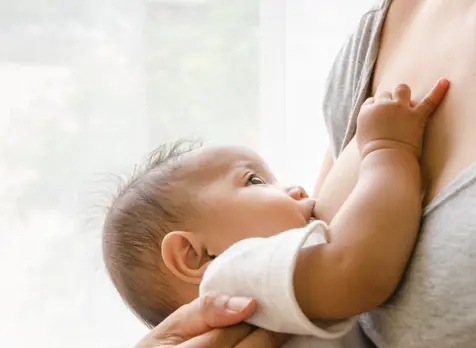Newborn Bottle-Feeding

Feeding your baby from a bottle, whether it's formula or breast milk, should be a relaxing and enjoyable time. Choose a comfy chair in a quiet place to relax and focus on your newborn baby.
Hold your baby so they can see you easily. Let their arms move and touch things while they eat. Talk and sing softly to your baby.
Some reasons you might bottle-feed
There are many reasons why you might choose to bottle-feed your newborn baby. It's essential you feel supported in your decision making. Some of these reasons might include:
-
Medical Reasons: You may have a medical condition or take medications that can make it unsafe for your baby or not possible for you to breastfeed.
-
Flexibility: Bottle-feeding can offer more flexibility, allowing you to share feeding responsibilities with your partner or other caregivers.
-
Breastfeeding Challenges: You may not be able to produce enough milk, have ongoing pain or not feel comfortable breastfeeding or feeding in public, leading you to consider formula feeding or a combination of breastfeeding and bottle feeding expressed breast milk, and/or formula (mixed feeding).
-
Surrogacy or Adoption: Your baby may have come into your family through surrogacy or adoption and you may choose formula feeding as their primary source of nutrition.
-
Personal Preference: You may simply prefer formula feeding or decide that it's the right choice for you and your family.
Ultimately, what matters most is making a choice that suits your unique circumstances and feeling confident and supported in that decision.
What equipment do you need for bottle-feeding your newborn?
For babies under 12 months, the only milk drink they should have other than breast milk is infant formula. Despite most infant formula’s being cow’s milk based, baby formulas are modified milk, so that the vitamins, minerals and proteins meet your baby’s nutritional needs, to support normal growth and development. It is important that infants under 12 months of age are not given cows milk as their milk feed.
To feed your baby, you'll need a bottle to hold either expressed breast milk or infant formula. Make sure to secure the teat firmly with the bottle's collar to prevent any spills.
When warming the bottle, use a container filled with warm water. If you have other young children, keep it out of their reach for safety.
Having a bib or cloth on hand can also come in handy for wiping your baby's mouth during feeding.
How to bottle-feed your newborn baby
-
1
Before feeding, make sure your baby is comfortable and their nappy is clean. If you can, remove any swaddling so that their hands can move freely.
-
2
Wash your hands.
-
3
Take the bottle and any other equipment you need to where you'll feed your baby.
-
4
Check the temperature and flow of the milk by dropping a little on the inside of your wrist.
-
5
Sit in a comfortable position. Hold your baby in the crook of your arm and place the bib or towel under their chin.
-
6
Note the time when feeding begins – aim for between 20 to 30 minutes.
-
7
Put the teat to your baby’s lips and they will usually open their mouth.
-
8
Hold the bottle at an angle to prevent your baby sucking in air. Make sure the teat and neck of the bottle contain milk.
-
9
Make sure the teat is above your baby's tongue, and far enough back into their mouth so they can suck easily. You might be able to improve their suck by supporting their lower jaw. Just place two fingers gently under their chin.
-
10
Encourage eye contact with your baby to build your relationship. Many babies also like to be quietly spoken to during the feed.
-
11
Keep an eye on your baby’s cues. About half way through the feed pause, sit your baby up, and help them to bring up wind by gently rubbing their back.
-
12
Similar to breastfeeding, you can alternative the side you are holding your baby on half way through the feed. This will help promote your baby’s development and allow them to see you from both directions.
-
13
If your baby falls asleep and you don't think they've had enough milk, unwrap them. Spend some time gently waking them by sitting them up.
-
14
After you've finished the feed, disassemble and wash the bottle and teat in hot soapy water and sterilise. It is important to sterilise the equipment until your baby is 12 months of age to reduce the risk of illness. If you cannot do this straight away, rinse the bottle and teat with cold water, so that it is easier to clean and sterilise when you do have time.
What not to do during bottle-feeds
- Avoid using a microwave oven to warm your baby's bottles, as it can be dangerous and is not recommended. Microwaves can heat milk unevenly, posing a risk of severe burns to your baby's mouth or throat.
- Don't jiggle your baby's chin or squeeze their cheeks to try and make them drink.
- Keep their feeding times reasonably short, preferably not exceeding 40 minutes. If your baby becomes distressed or falls asleep during this time, stop the feeding.
- Never leave your baby unattended with their bottle propped up on a rolled-up towel or pillow. Baby may inhale or choke on the milk and this can also lead to milk entering your baby's ear canals, potentially causing ear infections.
- Don't let your baby sleep with a bottle in their mouth. Pooled milk in their mouth may contribute to tooth decay and recurring ear infections.
Transporting newborn formula
The safest way to travel with formula is to take the premeasured cooled, boiled water and the powdered formula in separate containers and mix them when needed.
Warm the water by placing the bottle in a container of warm water. Once the water is warm, add the powder to the water, replace the bottle top and collar before shaking the bottle until the infant formula powder is well mixed with the water.
If you need to transport prepared formula or expressed breastmilk, it must be icy cold (5°C) when you leave the house.
Carry it in a thermal cool bag with a cooling brick to keep it cold. You must use the feed within two hours if you’re unable to refrigerate the bottle.
If able to refrigerate the bottle within the two hours’ travel time it can be stored for 24 hours from preparation time.











































